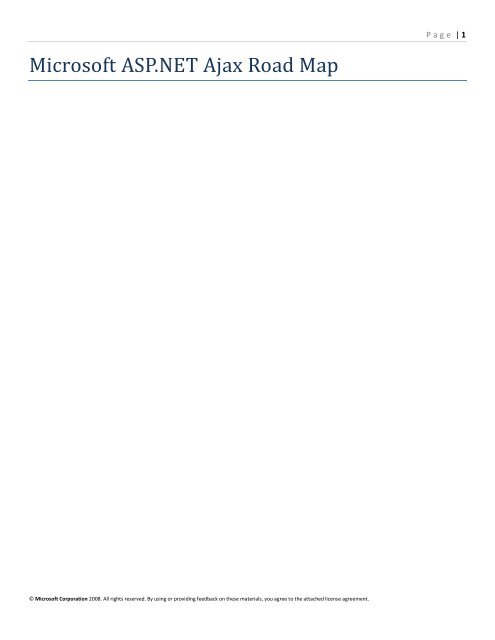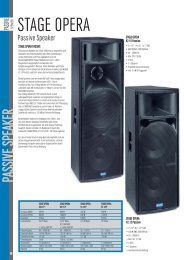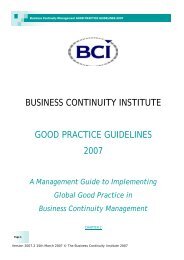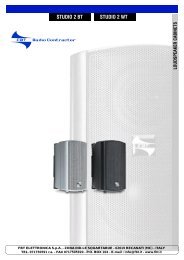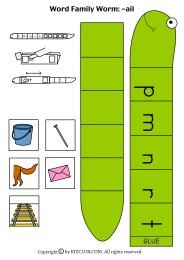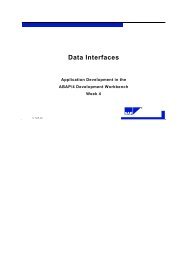Microsoft ASP.NET Ajax Road Map
Microsoft ASP.NET Ajax Road Map
Microsoft ASP.NET Ajax Road Map
Create successful ePaper yourself
Turn your PDF publications into a flip-book with our unique Google optimized e-Paper software.
<strong>Microsoft</strong> <strong>ASP</strong>.<strong>NET</strong> <strong>Ajax</strong> <strong>Road</strong> <strong>Map</strong><br />
© <strong>Microsoft</strong> Corporation 2008. All rights reserved. By using or providing feedback on these materials, you agree to the attached license agreement.<br />
P a g e | 1
<strong>Microsoft</strong> Corporation Documentation License Agreement<br />
© <strong>Microsoft</strong> Corporation 2008. All rights reserved. By using or providing feedback on these materials, you agree to the attached license agreement.<br />
P a g e | 2<br />
THIS IS A LEGAL AGREEMENT BETWEEN MICROSOFT CORPORATION ("MICROSOFT") AND THE RECIPIENT OF THESE MATERIALS,<br />
WHETHER AN INDIVIDUAL OR AN ENTITY ("YOU"). BY ACCESSING, USING OR PROVIDING FEEDBACK ON THE ATTACHED MATERIALS,<br />
YOU AGREE TO THESE TERMS.<br />
1. <strong>Microsoft</strong> grants You the right to reproduce and review this documentation (a) as a reference to assist You in planning and<br />
designing Your product, service or technology (“Product”) to interface with a <strong>Microsoft</strong> Product, as described in these Materials; and<br />
(b) to provide feedback on these Materials to <strong>Microsoft</strong>. All rights not expressly granted herein are reserved by <strong>Microsoft</strong>; this<br />
agreement does not give You rights under any <strong>Microsoft</strong> patents.<br />
2. This is a preliminary document and may be changed substantially prior to final commercial release of the <strong>Microsoft</strong> Product<br />
described herein. THIS DOCUMENTATION IS MADE AVAILABLE AS IS AND MICROSOFT MAKES NO WARRANTIES, EXPRESS, IMPLIED<br />
OR STATUTORY, AS TO THE INFORMATION CONTAINED IN IT.<br />
3. You have no obligation to give <strong>Microsoft</strong> any suggestions, comments or other feedback ("Feedback") relating to these<br />
Materials. However, any Feedback You voluntarily provide may be used in <strong>Microsoft</strong> Products and related specifications or other<br />
documentation (collectively, "<strong>Microsoft</strong> Offerings") which in turn may be relied upon by other third parties to develop their own<br />
Products. Accordingly, if You do give <strong>Microsoft</strong> Feedback on any version of these Materials or the <strong>Microsoft</strong> Offerings to which they<br />
apply, You agree: (a) <strong>Microsoft</strong> may freely use, reproduce, license, distribute, and otherwise commercialize Your Feedback in any<br />
<strong>Microsoft</strong> Offering; (b) You also grant third parties, without charge, only those patent rights necessary to enable other Products to<br />
use or interface with any specific parts of a <strong>Microsoft</strong> Product that incorporate Your Feedback; and (c) You will not give <strong>Microsoft</strong><br />
any Feedback (i) that You have reason to believe is subject to any patent, copyright or other intellectual property claim or right of<br />
any third party; or (ii) subject to license terms which seek to require any <strong>Microsoft</strong> Offering incorporating or derived from such<br />
Feedback, or other <strong>Microsoft</strong> intellectual property, to be licensed to or otherwise shared with any third party.
© <strong>Microsoft</strong> Corporation 2008. All rights reserved. By using or providing feedback on these materials, you agree to the attached license agreement.<br />
P a g e | 3<br />
In this document we will describe some of the proposed features that we are considering investing in future releases of<br />
<strong>ASP</strong>.<strong>NET</strong> AJAX, Visual Web Developer, and the <strong>ASP</strong>.<strong>NET</strong> AJAX Control Toolkit.<br />
We really appreciate your feedback, so this document is intended as much for you to provide an input to our direction as<br />
well as to give some indication of what the teams are investing in.<br />
<strong>Ajax</strong> frameworks have matured. Developers demand further higher-level helpers, components and functionality, not just<br />
a base library with class, interface and other OOP definitions. We want to make <strong>ASP</strong>.<strong>NET</strong> <strong>Ajax</strong> the first-class choice for all<br />
Web developers by enabling a lot more down to the metal, pure client-side scenarios, including on mobile devices, and<br />
integrating the framework with the new server-side MVC framework. This should provide developers who live on the<br />
bleeding edge of technology with the foundation, extensibility points and total control that they need.<br />
We also want to dramatically simplify client-centric <strong>Ajax</strong> development and UI experiences, bringing easy to use solutions<br />
to some of the hardest problems of client-side developments. This includes new and more intuitive templates, databinding<br />
and declarative syntax, as well as client-side data, new controls and even better integration with the server.<br />
In terms of the tools experience, we will further improve JavaScript IntelliSense, JavaScript debugging and add support<br />
for navigation and building JavaScript libraries.<br />
Before we delve into this, remember that the <strong>Microsoft</strong> <strong>ASP</strong>.<strong>NET</strong> <strong>Ajax</strong> framework can be used entirely as a client-side<br />
technology leveraging specific <strong>ASP</strong>.<strong>NET</strong> services or data, or even without an <strong>ASP</strong>.<strong>NET</strong> server, by utilizing the <strong>Microsoft</strong><br />
<strong>ASP</strong>.<strong>NET</strong> <strong>Ajax</strong> libraries directly.<br />
Contents<br />
Ship <strong>Road</strong>map ....................................................................................................................................................................... 4<br />
Framework Improvements and Enhancements .................................................................................................................... 4<br />
Make <strong>ASP</strong>.<strong>NET</strong> <strong>Ajax</strong> the first-class choice for all Web 2.0 developers............................................................................... 4<br />
DOM APIs ...................................................................................................................................................................... 4<br />
Enable great mobile <strong>Ajax</strong> applications .......................................................................................................................... 5<br />
Make client-centric <strong>Ajax</strong> development and UI experiences easy ...................................................................................... 6<br />
Client Data and UI Templates ....................................................................................................................................... 6<br />
Client Data Sources ....................................................................................................................................................... 8<br />
Client Data and Server Data .......................................................................................................................................... 8<br />
Accessibility .................................................................................................................................................................. 9<br />
Animation ..................................................................................................................................................................... 9<br />
Drag & Drop .................................................................................................................................................................. 9<br />
Client-side Controls and Behavior ............................................................................................................................... 10<br />
<strong>Ajax</strong> and MVC.............................................................................................................................................................. 10<br />
Interoperability ........................................................................................................................................................... 11
© <strong>Microsoft</strong> Corporation 2008. All rights reserved. By using or providing feedback on these materials, you agree to the attached license agreement.<br />
P a g e | 4<br />
Provide a great tools experience for <strong>Ajax</strong> development ................................................................................................. 11<br />
Reduced update lag for JavaScript IntelliSense ........................................................................................................... 11<br />
JavaScript IntelliSense support for a broader range of coding styles .......................................................................... 11<br />
Recognizing XML Metadata Comments in the Active Document ................................................................................ 11<br />
Recognizing Open<strong>Ajax</strong>-compliant XML Metadata Files ............................................................................................... 11<br />
JavaScript Navigation Tools ........................................................................................................................................ 11<br />
JavaScript Build Tools .................................................................................................................................................. 12<br />
Other Potentials.................................................................................................................................................................. 12<br />
High-level Feature Proposal Breakdown ............................................................................................................................. 12<br />
Conclusion .......................................................................................................................................................................... 12<br />
Ship <strong>Road</strong>map<br />
Our first generation of AJAX offerings were shipped in several vehicles: a standalone <strong>ASP</strong>.<strong>NET</strong> AJAX V1 release (which<br />
was then integrated into .<strong>NET</strong> Framework 3.5), a client-only <strong>Microsoft</strong> AJAX Library, a set of future features in the<br />
<strong>ASP</strong>.<strong>NET</strong> Futures, a toolset in Visual Studio 2008, and a set of controls and components in the <strong>ASP</strong>.<strong>NET</strong> AJAX Control<br />
Toolkit.<br />
Going forward, we are looking at simplifying this model into two major categories, to reduce confusion and create an<br />
approach consistent with our other offerings. We’d like your feedback on this approach.<br />
1. Fully supported framework and tools features will be released together, in full or update versions of our<br />
framework and tools releases. These will have CTPs, Betas, etc.<br />
2. We will offer our AJAX components on CodePlex, which will provide a single place to obtain updates to source<br />
code components, including the <strong>ASP</strong>.<strong>NET</strong> AJAX Control Toolkit, as well as features not yet part of the framework.<br />
We may have different landing pages, preview vehicles, etc. from time to time, but the two vehicles above will provide a<br />
definitive way to get our <strong>ASP</strong>.<strong>NET</strong> AJAX offerings.<br />
Framework Improvements and Enhancements<br />
These proposals are not defined in any priority order.<br />
Make <strong>ASP</strong>.<strong>NET</strong> <strong>Ajax</strong> the first-class choice for all Web 2.0 developers<br />
DOM APIs<br />
History: <strong>Microsoft</strong> <strong>ASP</strong>.<strong>NET</strong> <strong>Ajax</strong> 3.5 has DOM features that enable users to easily find elements ($get), get their<br />
coordinates (Sys.UI.DomElement.getBounds and getLocation), add and remove event handlers<br />
(Sys.UI.DomEvent) and manipulate their CSS classes (Sys.UI.DomElement.addCssClass,<br />
containsCssClass, toggleCssClass and removeCssClass) using a uniform, cross-browser API. We had
also been investigating further CSS selection of elements in the <strong>Microsoft</strong> <strong>ASP</strong>.<strong>NET</strong> “Futures” release using the CSS1<br />
selector syntax.<br />
Developers typically want a rich API set to allow for all the UI generation and handling that rich (<strong>Ajax</strong>) Internet<br />
Applications now demand. In v-next, we are considering greatly enhancing DOM APIs and manipulation by:<br />
© <strong>Microsoft</strong> Corporation 2008. All rights reserved. By using or providing feedback on these materials, you agree to the attached license agreement.<br />
P a g e | 5<br />
CSS 2.1 DOM selection with support for native querySelector APIs. This means many APIs related to parents,<br />
children, attributes, Css classes and styles in terms of selection, generation and manipulation. The following<br />
example will find all input elements of type text and whose value contains “foo”.<br />
$query(“input[type=text][value~=foo]”);<br />
Chainable DOM generation and manipulation APIs. This means the ability to create user code that utilizes<br />
selection and manipulation in a single statement for example, reducing code size. The following example will<br />
find all TEXTAREA elements with class “rich”, attach an event to each one of them that outputs a message to the<br />
trace every time the TEXTAREA is focused, set their width to the width of the document minus 10 pixels and<br />
attaches rich text behaviors to them.<br />
$query(“textarea.rich”)<br />
.addHandler(“focus”, function(e) {<br />
Sys.Debug.trace(“focused into “ + (e.eventTarget.id || “?”));<br />
})<br />
.setStyle(“width”, function() {<br />
return (document.body.clientWidth – 10) + “px”;<br />
})<br />
.create(Contoso.UI.RichTextBehavior, {<br />
showToolbar: true,<br />
fonts: [“Arial”, “Times”, “Courier”]<br />
});<br />
CSS selector-based event sink so that it becomes possible to set-up an event for all elements that satisfy a given<br />
selector at the time when the sink is created and later. This means that events could be generated at the<br />
window or component level, without the need to perform clean-up and re-generation when HTML elements are<br />
destroyed and re-created and manage their own event hook-ups. The following example shows setting up an<br />
event sink that will result in the title attribute of all spans getting dumped to the debug trace. This starts working<br />
at the moment the call is made and will continue working even for new spans that get created after that.<br />
$listen(“hover”, “span[title]”, function(e) {<br />
Sys.Debug.trace(this.title);<br />
});<br />
Enable great mobile <strong>Ajax</strong> applications<br />
Mobile access to Web applications is becoming more and more important as phones gain capabilities and approach<br />
desktop capabilities. We want to look at enabling the new generation of mobile browsers to run <strong>ASP</strong>.<strong>NET</strong> <strong>Ajax</strong><br />
applications.
Make client-centric <strong>Ajax</strong> development and UI experiences easy<br />
Client Data and UI Templates<br />
© <strong>Microsoft</strong> Corporation 2008. All rights reserved. By using or providing feedback on these materials, you agree to the attached license agreement.<br />
P a g e | 6<br />
History: If you have been following <strong>Microsoft</strong> <strong>ASP</strong>.<strong>NET</strong> <strong>Ajax</strong> from its “Atlas” days, you may recall that we introduced a<br />
declarative model for JavaScript objects called “xml-script”. This had had many elegant features and enabled live data<br />
bindings and rich UI templates. It was also very complex to understand and had performance issues that limited its<br />
success. It also meant separation of the XHTML markup defining the UI and templates from the declarative markup that<br />
performed such templates and binding. This means potentials for the two to be out-of sync and also introduced yet<br />
another ‘concept’ in an unfamiliar way.<br />
In v-next we want to reintroduce client-side data and templates. This means the ability to easily declare a re-useable UI<br />
template that is bound to repeated data of some form. In particular, we want to make it as easy as possible for a clientside<br />
application to consume data from Web Services or ADO.<strong>NET</strong> Data Services. Displaying this data should be simple<br />
and flexible. We want to make the most common and simple scenario of one-time, one-way binding expressible in the<br />
simplest possible way. This should also enable a richer live, bi-directional bindings where needed.<br />
Our initial thoughts mean the ability to define templates in markup directly in the page, and apply bindings on the<br />
markup itself. We will do this with the flexibility that JavaScript brings as an expression language and as a way to enrich<br />
the contents beyond plain HTML. Performance is of course a high priority, so our goals will ensure that this model can<br />
handle rich UI generation in a highly efficient manner.<br />
<br />
<br />
{{name}}<br />
{{description}}<br />
<br />
<br />
Sys.Application.add_initialize(function() {<br />
$create(Sys.UI.DataView, {<br />
template: $get(“template1”),<br />
data: myData<br />
}, {}, {}, $get(“repeater1”));<br />
}<br />
<br />
The above example repeats the html described in the template element over a data set and replaces parts of the<br />
rendering with data. Notice how arbitrary JavaScript expressions can be used in templates, e.g.({{ „products/‟ +<br />
id }}).<br />
<br />
…<br />
<br />
{{name}}<br />
{{description}}<br />
<br />
The above example is equivalent to the previous example, but uses a declarative approach to specifying the template<br />
and the data.
…<br />
<br />
<br />
<br />
<br />
<br />
<br />
© <strong>Microsoft</strong> Corporation 2008. All rights reserved. By using or providing feedback on these materials, you agree to the attached license agreement.<br />
P a g e | 7<br />
The above example is a more complex template. Here, the default one-way, one-time data bindings we had before are<br />
replaced with bidirectional, live bindings that are declared with a syntax that is reminiscent of WPF bindings. In addition<br />
to the generation of HTML, the template also includes the declarative creation of JavaScript behaviors attached to the<br />
HTML elements.<br />
<strong>Map</strong>pings between attribute prefixes that enable XHTML-compliant declaration and JavaScript types are declared on<br />
body or on the template’s outer tag (xmlns attributes). These prefixes are then used to declare which behaviors get<br />
attached to an element (sys:attach=”ac,wm”) and to set simple property values on them (wm:text=”Type<br />
the name of an airport”).<br />
It is also possible to create behaviors inside templates by writing plain JavaScript code inside blocks, which<br />
enables complete flexibility. The template engine exposes the latest created HTML element as $element and the index<br />
of the current data item as $index.<br />
<br />
…<br />
<br />
<br />
{{name}}<br />
<br />
{{description}}<br />
<br />
<br />
{{ features[i].name }}<br />
<br />
© <strong>Microsoft</strong> Corporation 2008. All rights reserved. By using or providing feedback on these materials, you agree to the attached license agreement.<br />
P a g e | 8<br />
Client Data Sources<br />
The client UI templates will support both one-way/one time binding to a simple JavaScript Array, and ‘live binding’<br />
where changes in the data automatically propagate to update the rendered UI (as a result of either property-change<br />
events or collection-change events) and vice-versa.<br />
To support these scenarios, we expect to implement a client DataSource class, which can:<br />
specify a source of data, such as an ADO.<strong>NET</strong> Data Service.<br />
request data from the source.<br />
cache data.<br />
save changes back to source.<br />
Expose methods such as insertRow.<br />
provide collection-change events on cached data.<br />
The client DataView control can bind to a client DataSource, through a live binding.<br />
In the following example the declarative syntax is used to bind the DataView (and its inline template) to a DataSource<br />
which uses an ADO.<strong>NET</strong> Data Service to request or save data:<br />
<br />
…<br />
<br />
<br />
<br />
{{ $index+1 }}. {{ CompanyName }}<br />
{{ Address }} {{ City }} {{ PostalCode }} <br />
Contact: {{ ContactName }} <br />
© <strong>Microsoft</strong> Corporation 2008. All rights reserved. By using or providing feedback on these materials, you agree to the attached license agreement.<br />
P a g e | 9<br />
A ClientDataSourceExtender control – used to extend the behavior of a normal server DataSource control in a similar<br />
way to the above ClientDataSource, so that it is exposed as a client DataSource control in the browser.<br />
A ClientDataView server control, which can be data-bound directly to a server DataSource control, but is rendered into<br />
the browser as a client DataView using client templating and data-binding. The ClientDataView will ensure that the<br />
server DataSource control is rendered as a client DataSource with source pointing back to the server DataSource control.<br />
Accessibility<br />
History: We had previously investigated accessibility back in the <strong>Microsoft</strong> <strong>ASP</strong>.<strong>NET</strong> <strong>Ajax</strong> 1.0 days, but at that time<br />
browsers had little support for WAI-ARIA.<br />
Given the maturing of existing and new accessibility standards we want to provide clear guidance and well-defined<br />
patterns for both component and application developers to achieve accessible compatible <strong>Ajax</strong> applications. This means<br />
that in any script components that we create we will implement accessibility patterns in all components that we develop<br />
and provide these along with clear guidance documentation for third party component and application vendors.<br />
This translates into APIs that we develop in the core framework to make accessibility easy to implement. We will provide<br />
support and guidance for keyboard navigation and focus management, screen readers, WAI-ARIA roles, high contrast<br />
and alternate contents.<br />
A stretch goal, but an important goal, would be to also provide ways to verify the accessibility of a component or<br />
application.<br />
Animation<br />
To provide rich behavior in the framework, we want to provide a consistent core animation framework much like that<br />
we have currently in the <strong>ASP</strong>.<strong>NET</strong> “Futures”. This will include simple animations such as fade or slide, as well as ways to<br />
combine them, allowing developers to create obvious transition effects between UI changes for example.<br />
We think that the core framework will be highly extensible, allowing 3 rd parties or application developers to easily<br />
extend and enrich.<br />
$query(“.sprite”).animate([<br />
new Sys.Animation.FadeIn(300),<br />
{<br />
“style.backgroundColor”: “#ff0000”,<br />
“style.fontSize”: “2em”),<br />
duration: 500<br />
},<br />
new Sys.Animation.FadeOut(300)<br />
])<br />
);<br />
This sample selects all elements with class “sprite” and animate them with first a fade-in effect that will last 300<br />
milliseconds, then will transition their background colors to red while taking their font size to 2em. Finally, a 300<br />
millisecond fade-out effect is applied.<br />
Drag & Drop<br />
We want to provide a flexible drag and drop framework and integrate it with components such as DataView.
Client-side Controls and Behavior<br />
© <strong>Microsoft</strong> Corporation 2008. All rights reserved. By using or providing feedback on these materials, you agree to the attached license agreement.<br />
P a g e | 10<br />
History: Currently the <strong>Microsoft</strong> <strong>ASP</strong>.<strong>NET</strong> <strong>Ajax</strong> framework does not ship any higher-level ‘components’ or controls in the<br />
server or client. There are some server-side controls that provide <strong>Ajax</strong>-like behaviors for <strong>ASP</strong>.<strong>NET</strong> server applications,<br />
UpdatePanel and UpdateProgress. The higher-level UI components have been provided by third parties and by<br />
the <strong>Ajax</strong> Control Toolkit.<br />
Many developers see the <strong>Ajax</strong> Control Toolkit as an integral part of the <strong>Microsoft</strong> <strong>Ajax</strong> stack, and so do we. We want to<br />
affirm our commitment to the Toolkit by dedicating more resources to creating new controls, fixing bugs and improving<br />
the existing controls.<br />
The <strong>Ajax</strong> Control Toolkit will continue to be a community project but in our v-next release we are considering developing<br />
new simple, core client-side components together with server-side controls and extenders. We have not yet determined<br />
the set of components that we might offer, but certainly in terms of the templates, data-binding and UI generation<br />
mentioned earlier, we are considering specific base data-bound controls such as Grid, DataView, as well as<br />
Validators (including an asynchronous custom validator that enables client-side code to validate fields against a<br />
custom server rule).<br />
We would also consider Layout controls to support UI generation and other navigation-style controls such as<br />
TreeView.<br />
Which controls get implemented first will highly depend on community feedback. We welcome suggestions and<br />
encourage you to communicate your preferences about which controls would be the most useful to you as well as what<br />
features you would expect on each of them. We identified the following controls as possible candidates:<br />
Grid: a client-side, templated grid control with client-side sorting, pagination and inline editing.<br />
TreeView: a client-side, templated and web-service aware tree with a full client-side object model.<br />
Asynchronous validator: enables asynchronous validation using custom server-side code.<br />
Upload: an upload control compatible that works outside of full postbacks, possibly with progress monitoring.<br />
Layout: a control that enables the easy construction of simple and dynamic layouts with user-configurable<br />
splitters.<br />
User control: an easy pattern to build reusable pieces of UI, analogous to server-side user controls.<br />
Rich text editor: a simple, cross-browser and extensible rich text editor.<br />
Chart: simple and extensible charting, possibly based on SilverLight.<br />
Progress bar: a skinnable control to convey progress information on long-running processes.<br />
Color picker: a control to pick colors.<br />
<strong>Ajax</strong> and MVC<br />
With the new complementary model for Web application development from <strong>ASP</strong>.<strong>NET</strong>, MVC, we want to ensure that the<br />
full suite of <strong>Microsoft</strong> <strong>Ajax</strong> functionality can be utilized through this paradigm, including the <strong>Ajax</strong> Control Toolkit. MVC<br />
developers want complete control over the rendering of the page and are typically more willing to write JavaScript code.<br />
In that spirit, we want to enable:<br />
- Partial rendering scenarios: We need to ensure that developers can create updateable areas of a Web page, or<br />
partial views, that do not require a full-page refresh. We also need to enable developers to easily create links to<br />
actions that will update the partial views. To do this, we need to build the client-side infrastructure that updates
© <strong>Microsoft</strong> Corporation 2008. All rights reserved. By using or providing feedback on these materials, you agree to the attached license agreement.<br />
P a g e | 11<br />
the DOM, downloads new scripts that may have been added during the partial update, and create the serverside<br />
object model that controls it. We believe that this can be accomplished using UserControls as partial views.<br />
- Controls and behaviors: We want to ensure that you can incorporate the RIA <strong>Microsoft</strong> <strong>ASP</strong>.<strong>NET</strong> <strong>Ajax</strong> behaviors<br />
and controls as well as register scripts through simple rendering helpers exposed off the “<strong>Ajax</strong>” property in the<br />
ViewPage.<br />
Interoperability<br />
<strong>Microsoft</strong> has recently set its commitment to interoperability as one of its top priorities. As part of that effort, we have<br />
been actively participating in the activities of the Open<strong>Ajax</strong> Alliance and in particular the Interop group that produces<br />
the Open<strong>Ajax</strong> hub.<br />
The Open<strong>Ajax</strong> hub enables disparate <strong>Ajax</strong> libraries and components to communicate with each other, such as <strong>Microsoft</strong><br />
<strong>ASP</strong>.<strong>NET</strong> <strong>Ajax</strong> and Prototype or Dojo. While <strong>Microsoft</strong> <strong>ASP</strong>.<strong>NET</strong> <strong>Ajax</strong> is compatible with the Open<strong>Ajax</strong> hub today, we want<br />
to make that easier for the application developer by providing a simple API to expose any <strong>Microsoft</strong> <strong>ASP</strong>.<strong>NET</strong> <strong>Ajax</strong> event<br />
as an Open<strong>Ajax</strong> publisher. The library will also properly register itself to the hub if it is present.<br />
We think that this can be built in a way that the current developer on <strong>Microsoft</strong> <strong>ASP</strong>.<strong>NET</strong> <strong>Ajax</strong> is unaffected, and that it is<br />
really an application developer’s decision to opt-in for. This allows the functionality to be ‘paid-for’ rather than bloating<br />
the framework even if it is unused.<br />
Provide a great tools experience for <strong>Ajax</strong> development<br />
Here is a list of ideas under consideration for Visual Studio <strong>Ajax</strong> Editing Support. Please note that a few proposals may<br />
be implemented in the next major release, some may be realized in subsequent release, and others may not be realized<br />
at all. Of source, feedback is welcome to help us prioritize.<br />
Reduced update lag for JavaScript IntelliSense<br />
For larger script libraries, JavaScript IntelliSense may take longer than usual to update. We are investigating methods to<br />
reduce this wait time.<br />
JavaScript IntelliSense support for a broader range of coding styles<br />
Much work has been done in Visual Studio 2008 SP1 to ensure IntelliSense compatibility with popular JavaScript<br />
libraries. In general, we would like to achieve IntelliSense compatibility with nearly any type of coding style.<br />
Recognizing XML Metadata Comments in the Active Document<br />
Currently, in order to see additional metadata in IntelliSense (type-information, summary text) for a member, that<br />
member must be defined in an externally referenced file. We would like to remove this restriction and allow this<br />
metadata to be available regardless of where it is defined.<br />
Recognizing Open<strong>Ajax</strong>-compliant XML Metadata Files<br />
The Open<strong>Ajax</strong> Alliance is working to increase the interoperability of <strong>Ajax</strong> libraries by creating an open standard for the<br />
description of these libraries. Our work here in the editor would be to natively read this data and merge it into our<br />
existing tooltips and IntelliSense.<br />
JavaScript Navigation Tools<br />
We’ve heard many requests in the category of “navigation aids for large files”. The current thinking is to provide a<br />
document outline tree view that allows someone to get a quick overview of a large file and also to jump to any line via
© <strong>Microsoft</strong> Corporation 2008. All rights reserved. By using or providing feedback on these materials, you agree to the attached license agreement.<br />
P a g e | 12<br />
the tree. The possibilities for the tree representation range from purely lexical to something more akin to the class view.<br />
For example, you would see a function and its prototype grouped together regardless of where they were defined.<br />
JavaScript Build Tools<br />
We will be investigating methods to integrate common JavaScript related tasks into the build process. This eliminates<br />
the need to manually invoke a checklist of tools and the possibility for forgetting one. Some possible modules include:<br />
Aggregate – In release build mode, merge multiple script files into one. This allows for the development-time<br />
file structure to be optimized for componentization and readability.<br />
Minify – In release build mode, compact your script to optimize for download speed.<br />
Static Analysis – Run basic checks against your file such as comparing documented function signatures against<br />
the actual ones to identify subtle bugs.<br />
Other Potentials<br />
We have many other ideas that we might simply produce and release as sample code, or into our “Futures” buckets and<br />
so does not become part of the supported framework for now. However, we’d like your input for these.<br />
Typically, we are considering an application profiling tool that allows you to inspect a particular page and understand its<br />
library script requirements. The tool will generate a list of scripts in their relevant order that will allow you to easily take<br />
advantage of the .<strong>NET</strong> FX 3.5 SP1 script combining feature on the ScriptManager control. This means you can<br />
further optimize the performance of your application.<br />
High-level Feature Proposal Breakdown<br />
The following table describes the breakdown of features and their current ‘bucket’ in terms of “futures”, destined for vnext<br />
or already considered part of v-next.<br />
Feature Proposal Futures or<br />
ACT<br />
v-next<br />
Likely for vnext<br />
<strong>Ajax</strong> and MVC X<br />
DOM manipulation APIs X<br />
Accessibility X<br />
Client data and templating X<br />
Client-side controls and behavior X<br />
Open<strong>Ajax</strong> X<br />
Animation X<br />
Drag & Drop X<br />
JavaScript Tools X<br />
Conclusion<br />
This is just a brief summary of some exploratory work that the <strong>ASP</strong>.<strong>NET</strong> and Visual Web Developer teams are<br />
investigating. We are highly interested in your comments, and suggestions which will help us decide not only the feature<br />
sets that we invest in, but the designs that we embark upon.
© <strong>Microsoft</strong> Corporation 2008. All rights reserved. By using or providing feedback on these materials, you agree to the attached license agreement.<br />
P a g e | 13<br />
So when will you start to see these improvements? We are likely to release sample code for the runtime improvements<br />
in a “Futures” form via the <strong>ASP</strong>.<strong>NET</strong> CodePlex project. You can already see a model for this design process from the<br />
<strong>ASP</strong>.<strong>NET</strong> team in the manner of the <strong>ASP</strong>.<strong>NET</strong> MVC code now released via Codeplex (www.codeplex.com/aspnet) and the<br />
supporting CTPs and documentation. Details will be coming soon!<br />
Many Thanks!<br />
The <strong>Microsoft</strong> <strong>ASP</strong>.<strong>NET</strong> and the Visual Web Developer Teams.


